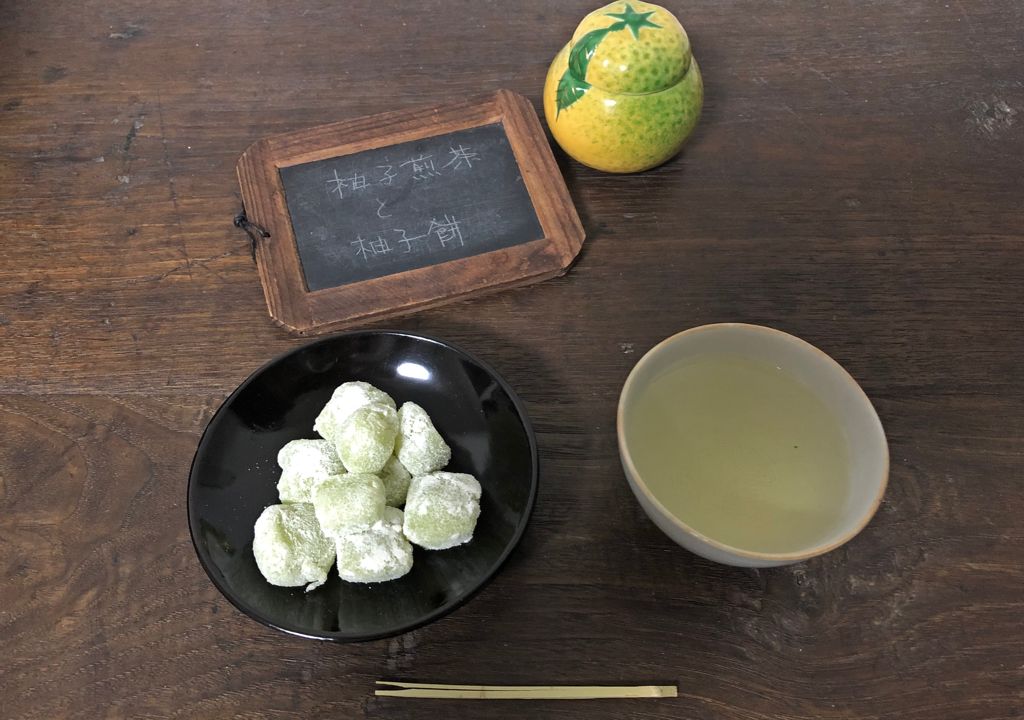September 2019 – Organic Yuzu Sencha from Nara and Kōchi
We prepared a Yuzu Sencha (柚子煎茶) this month, a Sencha (煎茶) mixed with zests of yuzu.
Organic Yuzu Sencha
A Sencha cultivated at the altitude of 500 meters in the highland of Nara (奈良) met yuzu (柚子) grown in the nature of Kōchi (高知). The tea is healthy and good in a completely organic mood.
We carefully select good tea leaves from the first harvest of the year (from the end of April to the middle of May). Usually the first harvest is dedicated to making Shincha or Gyokuro.
We use only the first part of tea branches, called Isshin Niyo (一芯二葉) or “a shoot and two leaves”. This precious part is very sweet and fresh, because it does not contain catechin (which causes bitterness) synthesized under the action of ultraviolet rays. Tea made entirely from this first part has quite a sweet character and a very delicate taste.
The name of the harvested part corresponds to the harvest order. The 2nd part is “a shoot and 3 leaves” (一芯三葉), the 3rd is “a shoot and 4 leaves” (一芯四葉) and the 4th is “a shoot and 5 leaves” (一芯五葉).
Kōchi is the largest producer of yuzu in Japan, namely 40 to 50 % of yuzu come from here. Yuzu is harvested in November. But September is the typhoon season. Since Kōchi prefecture faces the Pacific Ocean, it is very exposed to typhoons. Typhoons come from the South and move towards the north, taking the route of Pacific Ocean. Typhoons can negatively impact the yuzu harvest.

Yuzumochi with Yuzu Sencha
Yuzumochi (柚子餅), literally rice cake of yuzu for Yuzu Sencha. Japanese people often use yuzu for pastries, because the aroma is very good. But you have to pay attention! If you use too much yuzu, the taste could turn sour due to its bitterness. However, since Yuzu Sencha and this sweet tea are respectively moderate for yuzu taste, they don’t make any dissonance, but blend harmoniously.
Return to Baby
I already talked about the festival of Chrysanthemums dedicated to longevity (see blogpost of September 2018). Recently one of my friends turned 60 years old. The 60th birthday is special in Japan. We call it Kanreki (還暦), or return to the year of birth.
This concept is based on the twelve signs of Zodiac (rat, ox, tiger, rabbit, dragon, snake, horse, sheep, monkey, rooster, dog and boar) and the five nature elements (wood, fire, metal, earth and water) imported from ancient China. In 60 years, we return to our own year.
For example, in the case of my friend, he is born in 1959 and it was the year of Earth-Boar. At twelve year old (in 1971) it was the year of Fire-Boar, at 24 years old (in 1983) that of Water-Boar, at 36 years old (in 1995) that of Wood-Boar, at 48 years old (in 2007) that of Fire-Boar and finally, his Earth-Boar year has come back this year!
Being 60 years old means to start from zero like a baby. That made the custom to give an 赤いちゃんちゃんこ (red vest) which has the meaning of “the return to the baby”.
Nowadays we give something having red color as a gift of 60th birthday, like a necktie, a piece of underwear or a flower bouquet. We took a soba (蕎麦: buckwheat) course with him to celebrate his 60th birthday, because soba is the symbol of longevity, and we gave him a red wig!

Brewing Yuzu Sencha
The amount of tealeaves should be adapted according to the desired taste: it should be around 2 teaspoons (4 grams) of Yuzu Sencha for 160ml (5oz) of spring water. The infusion should last 60 seconds in water at 85ºC (185ºF). For the 2nd infusion, 45 seconds in boiling water and for the 3rd infusion, 1 minute 30 seconds in boiling water. Do not forget to pour until the last drop.
To make cold Yuzu Sencha, pour 1 liter of water with 10 grams of tealeaves and chill in a refrigerator for 6 hours. Enjoy your Yuzu Sencha!
If you have questions about Japanese teas, please do not hesitate to contact us!
